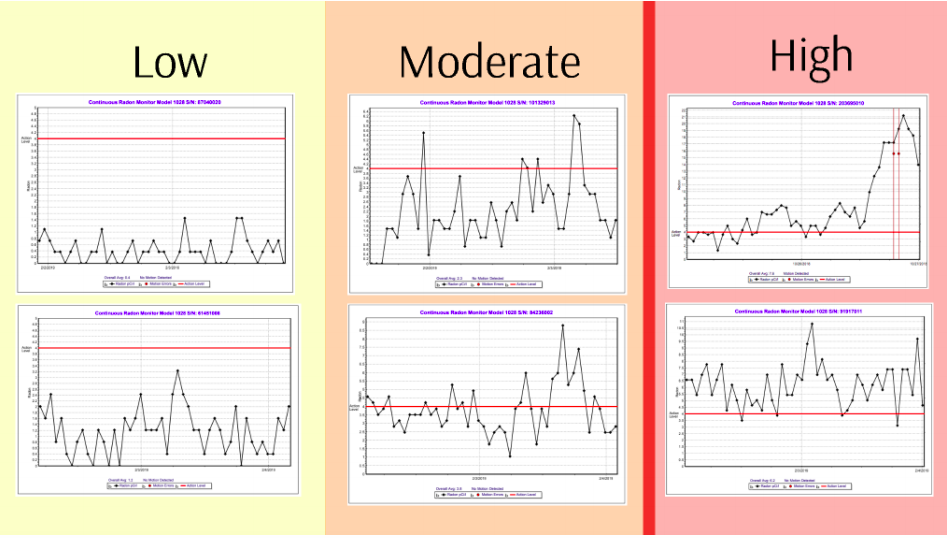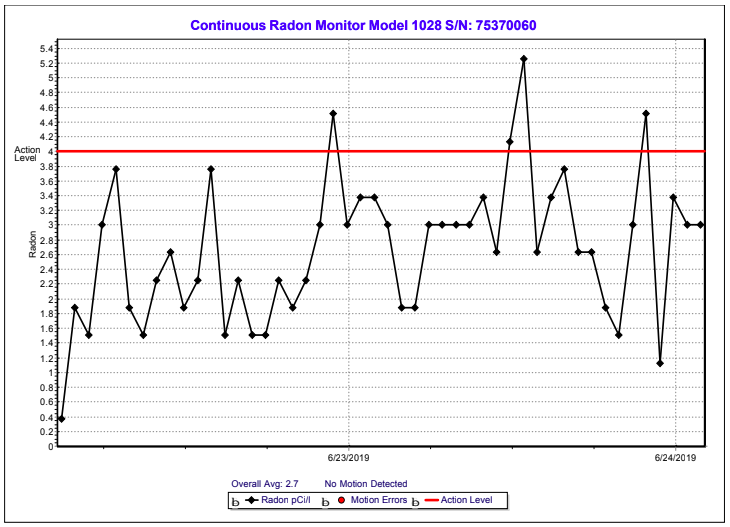When looking at your radon test report, the most important takeaway is to determine whether the results are low, moderate, or high. These classifications help you to decide how to move forward or what steps you should take next.
Keep in mind, the results of the short-term radon test are a snapshot of the current radon levels during the current testing period/conditions. Another test conducted during a different testing period, particularly with different weather conditions, will have different results. In an effort to control some of the factors that impact radon levels, short-term radon tests are conducted during "closed-house conditions." However, external factors, like rain, cannot be controlled. (Not all homes are impacted by rain, but those that are tend to have temporarily higher radon levels when the weather is wet/rainy than when it's clear/dry.)


What's normal?
The EPA estimates the average outdoor radon level nationwide to be around 0.4 pCi/L, so anything close to that is ideal. The average indoor radon level nationwide is estimated around 1.3 pCi/L, and our testing over the past year in the Triangle has averaged around 1.4 pCi/L. Anything below 4 pCi/L is considered acceptable, but the EPA recommends considering mitigation for levels 2-4 pCi/L (and definitely recommends mitigation for levels 4 pCi/L and above).
What causes fluctuations?

Fluctuations are normal and occur during every test. They can be caused by anything that impacts pressurization/airflow in the home: changes in barometric pressure, wind, precipitation, cycling of the HVAC system, exhaust fans, etc. The variations may seem relatively dramatic due to the scale of the graph. If you imagine the graph ranging from 0 to 20 pCi/L instead of 0 to 5 pCi/L (or the range you may see on your report), the measurements would look more consistent. Because fluctuations are expected, the overall average is much more indicative of long-term levels than any one individual measurement.
Should we re-test if results are above 4 pCi/L?
If the initial average is at or above 4 pCi/L, we’d recommend asking the seller to mitigate (or mitigate your own home if you're not part of a real estate transaction). The seller can either agree to go ahead and mitigate the home (or negotiate compensation), or they can conduct a re-test. The seller typically pays for the re-test because they’re the one who benefits from potentially lower results. If a second test is conducted, standard protocol is to average the results of the two tests to determine whether to mitigate.
Keep in mind that even if a re-test has lower results, the elevated levels in this test indicate that any future test might have elevated results (and you'd be exposed to elevated radon levels while living in this home). The only way to keep the radon levels consistently low is with an active radon mitigation system. If you'd want the home to be mitigated regardless of the results during a second testing period, a re-test would just be an added expense.
Should we conduct a long-term radon test?
If you’re curious about the radon levels outside of this 2-day testing period, we would recommend conducting a long-term radon test on your own after closing. You can purchase a kit online for about $30 (or multiples for different locations), and you leave the canister in the home for 3-12 months. During the long testing period, you maintain normal living conditions - opening windows/doors, using exhaust/ceiling fans, operating the HVAC system in different modes/temperatures, etc. Because of the extended duration, the long-term test takes into account seasonal and weather fluctuations and is the best way to measure your actual radon exposure with your living conditions. Long-term radon tests aren't an option during real estate transactions due to the minimum exposure time of 3 months, but they are the most accurate representation of your health risks. A long-term test kit can be purchased online through Accustar Labs.
How is a home mitigated?
The mitigation system works by pulling air out from underneath the foundation and ventilating it outdoors. A fan runs continuously to pull the air from the void space in the gravel underneath the slab (or from underneath the vapor barrier in a crawlspace). The system minimizes how much radon enters the home but doesn’t prevent all radon from entering (in a basement, radon can still enter through the front and side foundation walls, as the mitigation system only pulls air out from underneath the slab). The post-mitigation goal for basement homes is around 2 pCi/L (although we often see it go lower). Non-basement homes tend to have post-mitigation results around 1 pCi/L.


